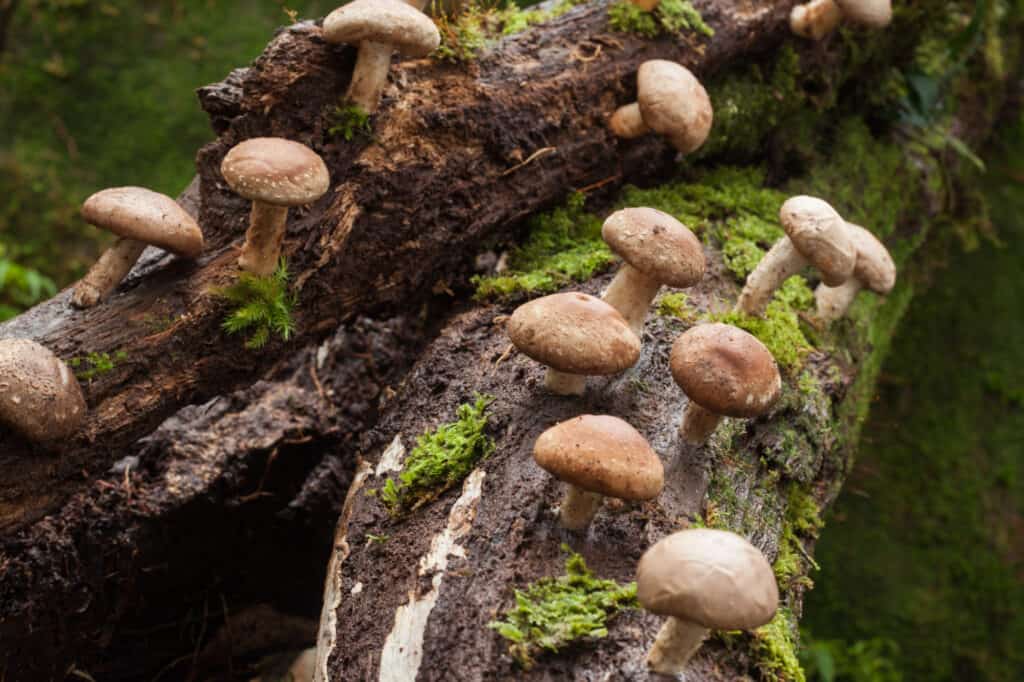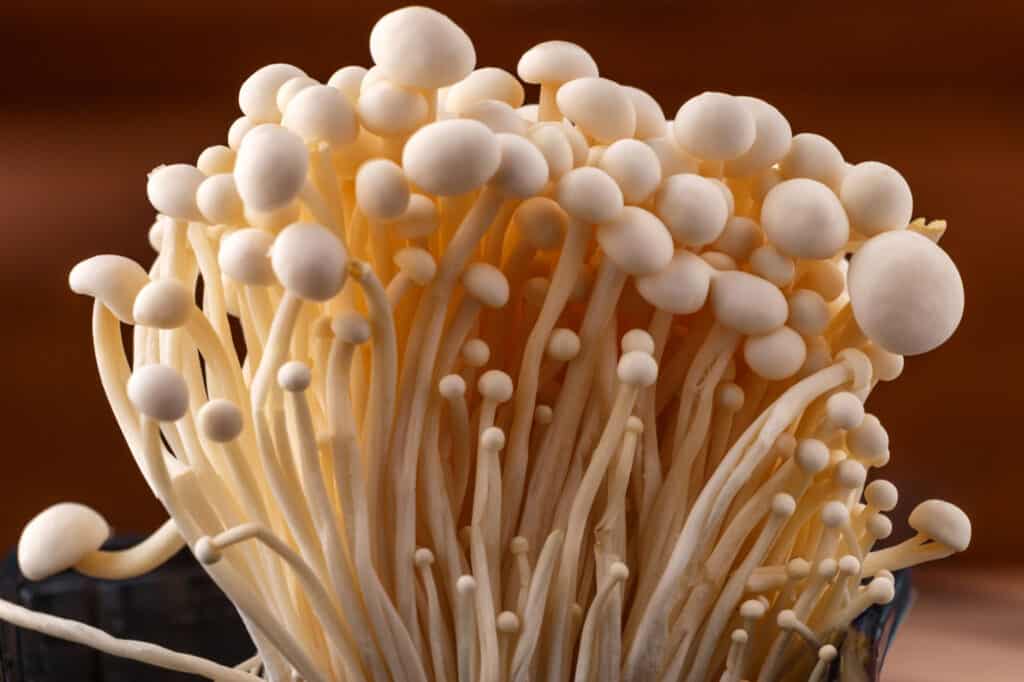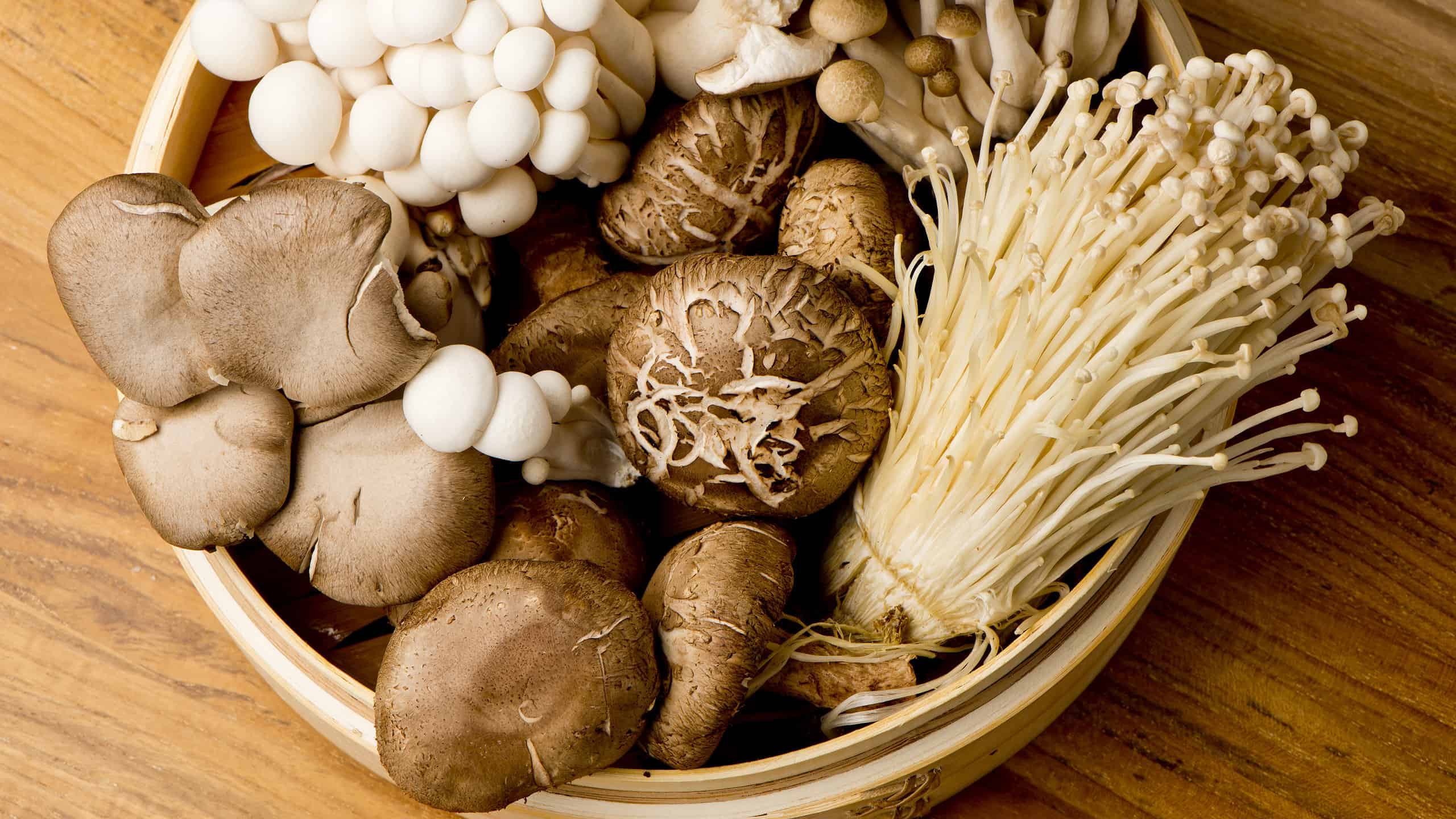Enoki and shiitake mushrooms are popular in many culinary dishes. Though fungi may be lumped into one group, these two mushrooms could not be more different. While enokis’ long, delicate stems are a prized addition to soups and stir-fries, shiitakes’ meaty texture tastes great on pizzas and in pasta. Let’s explore the differences between these two delicious mushrooms.
Origin
Enoki mushrooms have been growing wild in Eastern Asia as far back as at least 800 BCE. They can also be found growing naturally in North America. According to Specialty Produce, Japan was the first country to cultivate these unique-looking fungi.
Shiitake mushrooms are naturally distributed throughout Southeast Asia. Incredibly, the Mycological Society of San Franciso writes that the origin of shiitake mushrooms can be traced to the cretaceous period, over one hundred million years ago.
Cultivation and Growth
Enoki mushrooms grow on dead and decaying hardwood trees. Unlike shiitake, enoki mushrooms prefer the cooler temperatures of Eastern Asia and North America. They grow in clusters and are typically available for harvesting year-round.
Shiitake mushrooms grow year-round in Southeast Asia. They can be found on logs of trees such as shii, oak, maple, and beech. Shiitake mushrooms prefer warm, moist climates and have been cultivated in China since the 13th century. Today a number of countries, including the United States, farm shiitake mushrooms.

Shitake mushrooms grow on the logs of trees in moist, warm environments.
©puttography/Shutterstock.com
Etymology
Shiitake is pronounced shee-ta-kay. Their scientific name is Lentinula edodes. The word shiitake is a combination of the words “shii,” a Japanese tree similar to oak, and “také,” the Japanese word for mushroom.
Enoki is pronounced uh-now-kee. Their scientific name is Flammulina filiformis. The name enoki is derived from the Japanese language. However, in Mandarin Chinese, the name Jin Zhen Gu (金针菇) literally translates to “gold mushroom” or “golden noodle mushroom.”
Appearance
Enoki and shitake mushrooms are easily distinguished from one another by their appearance alone. Enoki are long, thin mushrooms that grow in tightly packed bouquets. They have small caps and tender stems that grow up to twelve centimeters in length. Enoki mushrooms are also white in color.
On the other hand, shiitake mushrooms have large, dark brown umbrella-shaped caps. The mushroom stems and undersides are cream-colored. According to GroCycle, shiitake mushrooms have a more delicate stem than cremini or portobello mushrooms, but they are still shorter and thicker than enoki.
Taste
Thanks to their long, spaghetti-like stems, enoki mushrooms are a popular addition to soups, stews, and stir-fries. They often appear in Japanese, Chinese, and Korean dishes. Enoki mushrooms have a mild and delicate taste with a crunchy, chewy texture.
Shiitake mushrooms have an intense, savory flavor, sometimes described as earthy or smoky. They also have a buttery, meaty texture. In fact, shiitake mushrooms make a great substitute for meat in many dishes. They are also a great addition to pizza and pasta.
Health Benefits
Mushrooms are generally considered to be full of health benefits. Enoki mushrooms are low in calories and high in fiber, antioxidants, and B vitamins. Shiitake mushrooms are said to help reduce cholesterol levels in the blood, reduce inflammation, and support immune health, according to WebMD.
Dangers of Enoki Mushrooms vs Shiitake Mushrooms
Neither enoki nor shiitake mushrooms are considered poisonous in the traditional sense. However, it’s still the safest option to cook both of these fungi before consuming them.
In April 2023, the Center for Disease Control (CDC), issued a warning linking a listeria outbreak to consumption of enoki mushrooms. Listeria is a genus of bacteria that can be especially dangerous for pregnant women, immunocompromised individuals, and people over the age of 65.

Edible and tiny, enoki mushrooms have a delightfully crisp texture.
©Tamakhin Mykhailo/Shutterstock.com
The CDC recommends that people at high risk should cook enoki mushrooms thoroughly before eating. They also encourage keeping enoki mushrooms separate from foods that won’t be cooked and washing your hands after handling raw enokis.
Although the consumption of raw shiitake mushrooms has grown in popularity, it’s probably not the safest idea. According to ANSES, eating raw or undercooked shiitake mushrooms can trigger a toxic reaction to lentinan known as flagellate dermatitis. This covers the entire body and face and causes severe itching for up to three weeks.
Summary of Enoki Mushrooms vs Shiitake Mushrooms
| Comparison | Enoki | Shiitake |
|---|---|---|
| Origin | Eastern Asia and North America | Southeast Asia |
| Cultivation and Growth | Decaying hardwood trees | Logs of trees in moist, warm environments |
| Etymology | Japanese, combination of “shii” and “také” (mushroom) | Japanese word |
| Appearance | Long, thin stalks, small caps, white in color | Umbrella-shaped brown caps, cream-colored stem and underside |
| Taste | Mild, crunchy, chewy | Savory, earthy, meaty |
| Health Benefits | High in fiber, antioxidants, and B vitamins | Helps reduce cholesterol levels and inflammation |
| Dangers | Listeria | Flagellate dermatitis |
The information presented on or through the Website is made available solely for general informational purposes. We do not warrant the accuracy, completeness, or usefulness of this information. Any reliance you place on such information is strictly at your own risk. We disclaim all liability and responsibility arising from any reliance placed on such materials by you or any other visitor to the Website, or by anyone who may be informed of any of its contents. None of the statements or claims on the Website should be taken as medical advice, health advice, or as confirmation that a plant, fungus, or other item is safe for consumption or will provide any health benefits. Anyone considering the health benefits of particular plant, fungus, or other item should first consult with a doctor or other medical professional. The statements made within this Website have not been evaluated by the Food and Drug Administration. These statements are not intended to diagnose, treat, cure or prevent any disease.
Thank you for reading! Have some feedback for us? Contact the AZ Animals editorial team.








